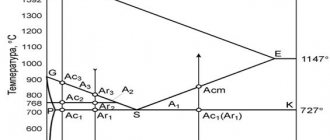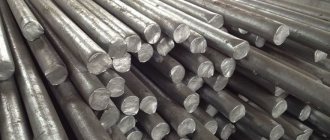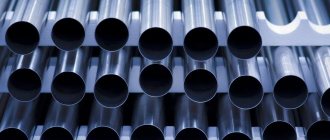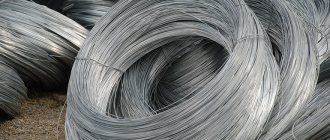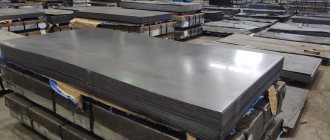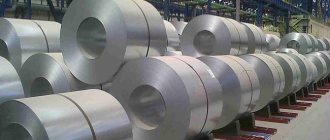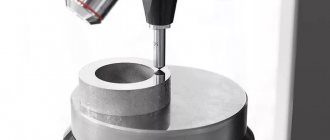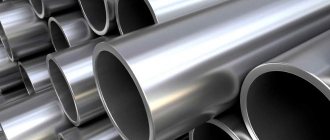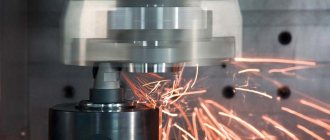There are hardly any people who doubt that there is nothing stronger than metal, especially if it belongs to the stainless group. But this statement is very general because stainless steel can have different shapes, wall thicknesses, etc. A stainless steel pipe 6x1, 10x0.5 can be bent by hand without much effort. In general, stainless steel has a lot of advantages. Even the name indicates that this metal does not rust and is indestructible; it is durable and aesthetically pleasing. The presence in it of a certain amount of chromium, nickel, and other elements makes the metal stable in conditions of sea water, acid, oil, and chlorine environments.
General characteristics of corrosion-resistant steel
Corrosion-resistant steels include metal alloys that are highly resistant to corrosion processes in different atmospheric and climatic conditions, water, aggressive gas and chemical environments.
Anti-corrosion properties are ensured by enriching carbon steel with special elements, the most important of which is chromium. Its minimum content in the structure of alloys is 10.5%. Currently there are about 250 brands of stainless steel. The most used alloying elements are nickel, cobalt, titanium, molybdenum, niobium. Carbon, which is necessarily included in the composition, gives the finished products the necessary strength and hardness. Changing the proportions of chemical elements produces a metal with different properties, intended for specific areas of use.
Chemical composition of steels 08x18n10t and 12x18n10t
The differences in the chemical composition of the two steels being compared are, at first glance, insignificant. In terms of their chemical composition, both alloys belong to the class of stainless alloyed heat-resistant austenitic steels. Both steels are reinforced with such an important additive as titanium.
Their chemical composition differs only in the percentage of carbon content. In steel 08x18n10t it is up to 0.12%,
and in steel 12x18n10t - only
no more than 0.08%
. All other alloying elements are introduced into the alloys in equal quantities. However, this difference between 08x18n10t and 12x18n10t somewhat changes the properties of these steels, and, naturally, the scope of their application. Although in other respects, steels are interchangeable.
Full chemical composition of steels 08x18n10t and 12x18n10t
| Stamps | C | Si | Mn | P | S | Cr | Mo | Ni | V | Ti | Cu | W | Fe |
| 08x18n10t | <0,08 | <0,8 | <2,0 | <0,035 | <0,02 | 17,0–19,0 | <0,3 | 9,0-11,0 | <0,2 | <0,7 | <0,4 | <0,2 | Rest |
| 12x18n10t | <0,12 | <0,8 | <2,0 | <0,035 | <0,02 | 17,0–19,0 | <0,5 | 9,0-11,0 | <0,2 | <0,8 | <0,4 | <0,2 | Rest |
Characteristics of stainless steels and their areas of application
All types of stainless steel compounds can be divided into several groups. Each combines materials with specific chemical properties and internal structure.
- Austenitic (highly alloyed chromium-nickel metals, marking A)
- Ferritic (chromium, marking F)
- Martensitic (carbon, marking C)
- Combined
One of the most common and sought after types. The high content of nickel and chromium (up to 33%) provides exceptional corrosion resistance and unsurpassed strength to the products. An important advantage is manufacturability. The material welds well, is more viscous and plastic than ferrite, and is not magnetic. Austenitic grades include: 04Х18Н10, 12Х18Н10Т, 12Х18Н9Т, 12Х18Н9, 08Х18Н10, AISI 304, AISI 316, etc. The scope of their use is wide. Austenitic types of alloys are used as a structural material from which products are made by cold stamping and welding. These can be various containers, casing, pipelines, equipment for food processing and storage, pharmaceutical, medical, laboratory equipment, parts for the mechanical engineering, automotive, aircraft industries, technological units for the chemical industry.
Brands: 15Х28, 08Х18Т, etc. This group of metals has a high chromium content (up to 20%). It ensures product resistance to extremely aggressive chemical environments and high magnetic properties. Anti-corrosion resistance is lower than that of metals of the austenitic group, therefore ferritic types are used in those areas where the requirements for this parameter are not so significant. The main consumers of chromium ferritic steels are manufacturing enterprises in the chemical industry, heavy engineering, and the energy sector. They are used for the production of equipment and parts operating in acidic and alkaline solutions, household instrument making, and the food industry.
Grades: 20Х13, 40Х13, 30Х13, etc. Due to the high carbon content, these are the most durable alloys among stainless steel. Metal products of this group are extremely wear-resistant, work well at high temperatures, but are more susceptible to corrosion processes. This type of metal can be subject to thermal hardening; this type includes corrosion-resistant, heat-resistant steel, which successfully resists oxidation and is suitable for use at high temperatures. Metal products retain their original properties even under constant thermal influence; the material is characterized by a minimal content of harmful impurities.
Examples of grades: 08Х22Н6Т, 12Х21Н5Т, etc. Combined grades can have an austenitic-martensitic or austenitic-ferritic structure and organically combine the positive properties of alloys of these types.
Useful
Designation of alloying elements in stainless steels The influence of the main alloying elements on the properties of stainless steels Compliance of foreign standards with Russian GOST Why is one brand of stainless steel magnetic and another not? What is “Food Stainless Steel”? The most common types of surface of stainless steel sheets
Designation of alloying elements in stainless steels
- In the initial part of the stamp there are numbers (two or one) showing the carbon content.
- Two numbers indicate its average content in the alloy in hundredths of a percent, and one – in tenths. There are also steels that do not have numbers at the beginning of the brand name. This means that the carbon content in these alloys is within 1%.
- The letters that can be seen behind the first digits of the brand name indicate what the alloy is made of.
- The letters that give information about a particular element in its composition may or may not have numbers. If there is a number, then it determines (in whole percentages) the average content of the element indicated by the letter in the composition of the alloy, and if there is no number, then this element is contained in the range from 1 to 1.5%.
X - chromium N - nickel K - cobalt M - molybdenum B tungsten T - titanium D - copper G - manganese C - silicon F - vanadium P - boron A - nitrogen B niobium E - selenium C - zirconium U - aluminum
The influence of the main alloying elements on the properties of stainless steels
Chromium (Cr):
- is the main element of steel, determining its resistance to oxidation (corrosion). Chromium sharply increases the corrosion resistance of steel when it increases in the alloy above 12.5%, starting from this concentration a dense oxide film of Cr2O3 is formed on the surface (chromium actually makes steel stainless, for example, steels 20Х13, 30Х13, 40Х13, etc.) ;
- when the chromium content in steel is 12-14%, the thermal conductivity of steel is 2 times less than pure iron, and the electrical resistance increases 3 times;
- provides increased strength at elevated temperatures, the addition of chromium increases the hardness and strength of steel without reducing its ductility;
- reduces the impact strength of steel.
Nickel (Ni):
- The main function of nickel is to stabilize the austenitic structure of steel; such a structure is especially strong and elastic. The minimum amount of nickel capable of stabilizing the austenitic structure is 8% (this is exactly how much nickel is found in the most common imported steel AISI 304);
- the presence of 8-10% nickel in steel provides it with good ductility and good forming properties;
- improves the weldability of steel and further increases the resistance of steel to oxidation (corrosion) in the weld area;
- nickel increases the heat resistance of steel (especially in relation to resistance to deformation);
- Thanks to nickel, stainless steel polishes better and is more scratch resistant than conventional steels (brushed and mirrored surfaces).
Molybdenum (Mo):
- increases the resistance of steel to oxidation (corrosion) at high temperatures, reduces the resistance of steels to pitting corrosion;
- increases red resistance, elasticity, tensile strength;
- provides additional thermal strengthening.
Titanium (Ti):
- increases the strength of steel;
- Titanium is added to stainless steels to prevent intergranular corrosion.
Carbon (C):
- with an increase in carbon to 0.8%, the hardness and strength of the steel increases, but leads to an increase in the threshold of cold brittleness (for example, steels 40Х13 and 95Х18 are used for the production of knives);
- the more carbon there is in the steel, the more difficult it is to process by cutting, the worse it deforms and the worse it welds (for example, the most common commercially available imported steels of the 300 series AISI304/321/316 have 0.8% carbon in their composition, which gives them a wide range of applications compared to domestic steel 12x18n10t).
Compliance of foreign standards with Russian GOST.
Currently, almost all stainless steel products supplied to our country are marked according to AISI, DIN, or EN standards. Let's consider the compliance of these standards with Russian GOST.
AISI (American Iron and Steel Institute), American Institute of Iron and Steel
The designation of standard stainless steels according to AISI includes three numbers followed by one, two or more letters in some cases. The first digit of the designation determines the steel class. Thus, the designations of austenitic stainless steels begin with the numbers 2XX and 3XX. While ferritic and martensitic steels are defined in class 4XX. Moreover, the last two digits, unlike carbon and alloy steels, are in no way related to the chemical composition, but simply determine the serial number of the steel in the group.
The additional letters and numbers following the numbers used to designate AISI stainless steels mean:
xxxL – Low carbon content < 0.03% xxxS – Normal carbon content < 0.08% xxxN – Nitrogen added xxxLN – Low carbon content < 0.03% + nitrogen added xxxF – Increased sulfur and phosphorus content xxxSe – Selenium added xxxB – Silicon added xxxH – Extended range carbon content xxxCu – Copper added
For example:
Steel 304 belongs to the austenitic class, its carbon content is <0.08%. At the same time, in steel 304L carbon is only <0.03%, and in steel 304H carbon is determined in the range of 0.04 – 0.10%. The specified steel, in addition, can be alloyed with nitrogen (then its name will be 304 N) or copper (304 Cu).
In steel 410, which belongs to the martensitic-ferritic class, the carbon content is <0.15%, and in 410S steel the carbon content is <0.08%. In contrast to 430 steel, 430F steel has a higher content of sulfur and phosphorus, and selenium is also added to 430F Se steel.
DIN (Deutsches Institut für Normung) – German Institute for Standardization.
In the DIN marking system, unlike the Russian one, all chemical elements included in the composition are first listed, and then their mass contents are indicated. At the beginning of the designation the letter X is followed by a number corresponding to the carbon content multiplied by 100, then by the chemical symbols of the most important alloying elements, then by a number reflecting the average content of the most important alloying elements.
For example:
Х12Cr-Ni17 7 – high-alloy chromium-nickel steel containing <0.15% C, 16-18% Cr; 7-8% Ni; <2% Mn; <1% Si. X5Cr-Ni-Mo18 10 – high-alloy chromium-nickel-molybdenum steel containing 0.07% C; 16.5-18.5% Cr; 10.5-12.5% Ni; 2-2.5% Mo.
EN (European Norm) - European standards - >standards adopted by the European Committee for Standardization (CEN) In them, the steel grade is presented as 1.XXXX, where:
- 1. determines that this material belongs to steel;
- The next two digits after 1 determine the number of the steel group, and the last two – the serial number of the steel in the group.
By the group number you can unambiguously determine what type a particular steel belongs to.
1.40ХХ – 1.45ХХ – stainless steels 1.46ХХ – 1.49ХХ – heat-resistant and acid-resistant steels
For example:
1.4016 - AISI 430 (12Х17) 1.4301 - AISI 304 (03Х18Н10) 1.4541 - AISI 321 (08х18Н10Т) 1.4842 - AISI 410S (10Х23Н18)
Table of correspondence between GOST steel grades and standards of other countries.
| GOST | Euronorms (EN) | AISI |
| 12X15G9ND | ______ | AISI 201 |
| 12X17G9AN4 | 1.4373 | AISI 202 |
| 15Х17Н7 | 1.4310 | AISI 301 |
| 12Х18Н9 | ———- | AISI 302 |
| 08Х18Н10 | 1.4301 | AISI 304 |
| 03Х18Н11 | 1.4306 | AISI 304L |
| 03X18AN11 | 1.4311 | AISI 304LN |
| 12Х18Н12 | 1.3955 | AISI 305 |
| 06Х18Н11 | 1.4303 | AISI 305L |
| 08Х20Н11 | 1.4331 | AISI 308 |
| 20Х23Н13 | 1.4833 | AISI 309 |
| 03Х24Н13Г2С | 1.4332 | AISI 309L |
| 20Х23Н18 | 1.4843 | AISI 310 |
| 10Х23Н18 | 1.4842 | AISI 310S |
| 20Х25Н20С2 | 1.4841 | AISI 314 |
| 08Х17Н13М2 | 1.4436 | AISI 316 |
| 03Х17Н13М2 | 1.4404 | AISI 316L |
| 03Х17Н14М3 | 1.4435 | AISI 316S |
| 03X17N13AM3 | 1.4429 | AISI 316LN |
| 1Х16Н13М2Б | 1.4580 | AISI 316Сd |
| 08Х17Н13М2Т | 1.4571 | AISI 316Ti |
| 08Х19Н13М3 | 1.4449 | AISI 317 |
| 03Х19Н13М3 | 1.4438 | AISI 317L |
| 08Х18Н14М2Б | 1.4583 | AISI 318 |
| 08Х18Н10Т | 1.4541 | AISI 321 |
| 12Х18Н10Т | 1.4878 | _________ |
| 08Х25Н4М2 | 1.4462 | AISI 329 |
| 15Х12 | _____ | AISI 403 |
| 08Х12Т1 | 1.4512 | AISI 409 |
| 10Х13 | 1.40006 | AISI 410 |
| 08Х13 | 1.4000 | AISI 410S |
| 15Х13Н2 | _______ | AISI 414 |
| 20Х13 | 1.4021 | AISI 420 |
| 12Х15 | 1.4001 | AISI 429 |
| 12Х17 | 1.4016 | AISI 430 |
| 08Х17Т | 1.4510 | AISI 430Ti |
| 20Х17Н2 | 1.4057 | AISI 431 |
| 12Х17М | 1.4113 | AISI 434 |
| 12Х17Б | 1.4522 | AISI 436 |
| 15Х5М | 1.7362 | AISI 501 |
| 15Х9М | 1.7386 | AISI 504 |
| 09Х17Н17У | 1.4503 | AISI 631 |
| 06ХН28МДТ | 1.4503 | AISI 904L |
Why is one brand of stainless steel magnetic and another is not?
A little theory: A magnetic field with a certain level of its intensity acts on bodies placed in it in such a way that it magnetizes them.
Ferromagnets are substances that, in particular, include iron, cobalt and nickel, which are capable of actively magnetizing, even when placed in weak magnetic fields. We are used to identifying stainless steel using a magnet. It is believed that “real stainless steel” should not be magnetic, but in practice this diagnostic method does not always allow obtaining a reliable result. Why is this happening?
The term “stainless steel” refers to various materials, the composition of which may contain ferrite, martensite or austenite, as well as their various combinations. The characteristics of stainless steel depend on the phase components and their ratio. So, which stainless steel is magnetic and which is not?
Stainless steels that are magnetic.
Martensites and ferrites are strong ferromagnets. Such materials are not afraid of corrosion, but at the same time the magnet affects them, just like ordinary carbon steel. The presented group of stainless steels includes chromium or chromium-nickel steels of the following groups:
- Martensitic – is a ferromagnet in its pure form. These are mainly nickel-free steels 20Х13, 30Х13, 40Х13, as well as some steels alloyed with nickel, for example steel 14Х17Н2;
- Ferritic – A common magnetic steel of the ferritic type, which, due to the low carbon content in its chemical composition, is softer than martensitic alloys, is 08Х13 and its imported analogue AISI 410;
- Martensitic-ferritic – A popular brand of magnetic stainless steel, the internal structure of which consists of martensite and free ferrite, is 12X13 and its relative imported analogue AISI430.
Stainless steels that are not magnetic.
Most often, chromium-nickel or chromium-manganese-nickel alloy is used to produce stainless steel. These materials are non-magnetic.
- Austenitic – The most popular brand of stainless steels, which occupy a leading place among non-magnetic steel alloys, is 08Х18Н10Т, as well as steels of this type 08Х18Н10, 12Х18Н10Т, 10Х17Н13М2Т and their foreign analogs of the 300th series AISI 304/321/316 and others;
- Austenitic-ferritic - These materials are based on chromium and nickel, and manganese can be used as additional alloying elements.
When more than 9% manganese is added to an alloy, it becomes non-magnetic.
An example is the imported steels AISI 201 (12Х15Г9НД) and AISI 202 (12Х17Г9АН4).
What is “Food Stainless Steel”?
We often hear the term “food grade stainless steel”. Let's figure out what lies behind this. We will not find such a term anywhere in Russian GOST, since this name was invented in everyday life. “Food grade stainless steel” is something we encounter every day in our kitchens (edging the surface of many kitchen stoves, range hoods, microwave oven chambers, etc.), in the bathroom (washing machine drum), in shopping centers (stair railings) ) etc. and so on.
In general, “food grade stainless steel” is a universal product for many areas of activity where certain corrosion resistance, acid resistance, heat resistance and heat resistance are required. Here are some of the most common and in demand brands of food grade stainless steel today and their areas of application:
- 08Х18Н10/08Х18Н10Т (AISI304/AISI321) is perhaps the most common grade of “food grade stainless steel” used in the food industry, and has a composition that excellently resists intergranular corrosion, has a high level of weldability and versatility for many types of production. — 08Х13 (AISI 409) — used for the manufacture of kitchenware and cutlery. It is used to make microwave oven chambers, kitchen hoods, and edging for kitchen stoves;
- 12X13 (AISI 410) – used for the production of equipment elements used in the field of winemaking and food waste processing, for the production of alcohol and drinks from it. This steel has high heat resistance in mildly aggressive environments, excellent resistance to corrosion;
- 20Х13–40Х13 (AISI 420) – often used for the manufacture of all types of sinks (both household and industrial), utensils for heating, as well as for hygienic processing of food products. These alloys perfectly resist high-temperature rusting, they have good ductility and wear resistance;
- 08Х17 (AISI 430). They are indispensable in cases where it is necessary to make dishes in which food will be subjected to heat treatment. In environments containing sulfur, it demonstrates a high level of anti-corrosion resistance, is characterized by good deformability and strength, and has an increased thermal conductivity coefficient;
- 08Х17Т (AISI 439), from which sinks and other sanitary fixtures, clothes washing machines, and refrigeration units are produced. But in general, this alloy is considered quite universal and suitable for use in different operating conditions.
The most common types of surface of stainless steel sheets
- 1 D or M2B-M4B (matte) - the usual version for further processing, the surface of the sheets is less smooth than 2B and 2D, hot-smoked, with annealing and etching;
- 2B or M2A-M4A (matte, smooth) – very smooth surface, cold-rolled, with annealing and etching;
- 1 G / 2 G or 4 N / 5 N (polished) - unidirectional texture, slightly reflective. The surface of the metal is very smooth (roughness Ra = 1.20 - 1.50 µm), which does not reflect, but shimmers with the colors of the rainbow, c/c, additional processing by wet or dry grinding with fine-grained belt sandpaper or matte polishing (wet grinding using cooling oil). Standard types of surface finish (grit) 180, 240, 320;
- 2 R or VA (mirror) – the metal surface is very smooth (roughness Ra = 0.05 μm), reflects, but the reflection is not clear, smoother and brighter than 2B, cold-cotton, fired in a vertical oven using caustic ammonia ( finishing rolling on a temper mill is possible);
- 1M or Tear Piate (corrugated) – hot rolling with knurling of a pattern (“lentil”, “quintet”, etc.);
- 2M or DECO (decorated) - textured stainless steel, has a clearly defined pattern
Most popular brands:
GOST 20Х13 (AISI 420, DIN 1.4021)
– stainless steel with a martensitic structure, cannot be welded, is not prone to temper brittleness, and does not form internal defects during the production process. Used for the manufacture of measuring and cutting tools, springs, leaf springs.
GOST 12Х17 (AISI 430, DIN 1.4016)
– ferritic stainless steel heat-resistant grade, does not contain nickel. Characterized by good anti-corrosion resistance in moderately aggressive chemical environments and high temperatures.
GOST 12Х18Н9 (AISI 304, DIN 1.4301)
– a heat-resistant, corrosion-resistant alloy used in welded structures in contact with aggressive environments. It is used for sheet parts, welded equipment, heat exchangers, pressure devices.
GOST 08Х18H10 (AISI 304H, DIN 1.4948)
– an austenitic type of heat-resistant, corrosion-resistant alloy, used for the production of rolled pipes, components and assemblies for the chemical and engineering industries, heat exchangers, and industrial tanks.
GOST 03Х18H11 (AISI 304L, DIN 1.4306)
– chromium-nickel grade is used for the production of equipment, tanks and pipelines for the chemical industry, in the production of nitric acid and other aggressive substances.
GOST 08Х18H10Т (AISI 321, DIN 1.4541)
– a stainless, heat-resistant and heat-resistant alloy, non-magnetic, resistant to oxidation and has good weldability without preheating. It is used as food and technical stainless steel for the production of rolled sheets and pipes, welded equipment, the manufacture of containers, tanks, tanks and equipment in the chemical and oil and gas industries.
GOST 03Х17H14М2, 03Х17H14М3, (AISI 316, 316S, 316L)
– non-hardening austenitic grade, areas of application – welded parts, equipment for the pulp and paper and chemical industries, boiler bodies, tanks and installations for the coal industry.
GOST 08Х17H13М2Т (AISI 316Ti, DIN 1.4571)
– structural heat-resistant heat-resistant stainless alloy is used for fasteners and welded structures in various industries.
GOST 20Х23H18 (AISI 310S, DIN 1.4845)
– heat-resistant and heat-resistant austenitic stainless steel used for the manufacture of forgings, clamps, combustion chambers, fasteners and boiler elements, used pipes, couplings.
When choosing stainless steel, you should take into account the operating conditions of the metal, the expected load, and the necessary additional properties of the product. If you are in doubt about how to choose the right stainless steel, it is better to contact a specialist. Leave a request on the website, and our managers will give recommendations on selecting the optimal grades of stainless alloys for the given operating conditions.
Mechanical properties of 12Х18Н10Т
| Section, mm | Section, mm | B, MPa | 0.2, MPa | 5, % | , % |
| Rods. Quenching 1020-1100 °C, air, oil or water. | 60 | 510 | 196 | 40 | 55 |
| The rods are ground and processed to a specified strength. | 590-830 | 20 | |||
| Hard-worked rods. | <5 | 930 | |||
| Stainless steel sheets, hot-rolled or cold-rolled. Quenching 1000-1080°C, water or air. | >4 | 530 | 236 | 38 | |
| Stainless steel sheets, hot-rolled or cold-rolled. Quenching 1050-1080°C, water or air. | <3,9 | 530 | 205 | 40 | |
| Stainless steel sheets, hot-rolled or cold-rolled, hard-worked | <3,9 | 880-1080 | 10 | ||
| Forgings. Quenching 1050-1100°C, water or air. | <1000 | 510 | 196 | 35 | 40 |
| Heat treated wire. | 1,0-6,0 | 540-880 | 20 | ||
| Seamless hot-deformed pipes without heat treatment. | 3,5-32 | 529 | 40 |
Stainless steel concept
Let's give a definition: stainless steel is a complex alloy steel that is resistant to rust in atmospheric conditions and corrosion in aggressive environments. 1
Its resistance to corrosion differs from conventional carbon steels and therefore is widely used in the food industry, oil and gas and chemical industries for operation with highly aggressive environments and food products, since during storage, oxides and other substances do not form upon contact of the liquid and the surface of the container, which may affect the properties of the stored product.
What is stainless steel from a chemical point of view? — This is an alloy with a minimum mass fraction of chromium of 10.5% and a maximum mass fraction of carbon of 1.2%. 2
In simple terms, stainless steel is made by adding alloying substances to iron in different proportions to obtain the required characteristics.
Thus, the main alloying element is chromium Cr. The alloys also additionally contain carbon C, nickel Ni, silicon Si, manganese Mn, titanium Ti, niobium Nb, cobalt Co, molybdenum Mo, vanadium V, sulfur S, phosphorus P, tungsten W, aluminum Al, copper Cu, cobalt Co.
Scope of application
Thanks to these characteristics, steel has found wide application in:
- welding equipment;
- seamless pipes made of thin metal;
- chemical, oil and food industries;
- areas with products operating at high temperatures (blast furnace fittings, heat exchangers, boilers);
- decorative elements;
- medical equipment.
In conclusion, it is important to note that steel 12x18n10t is stronger than 08x18n10t. This indicator is lost with increasing temperature, but metal without heat treatment does this more slowly.
Source

